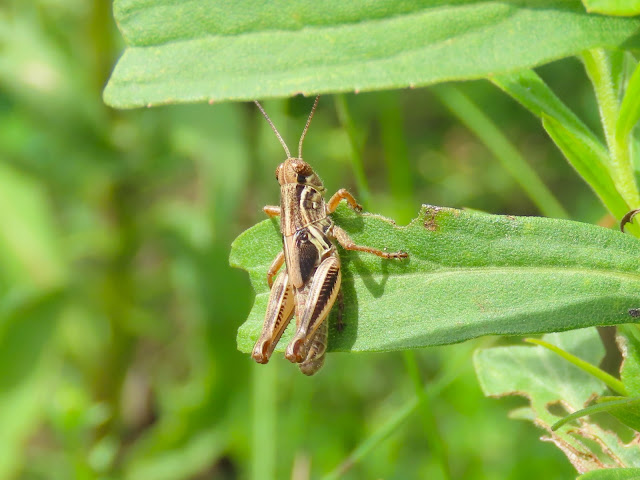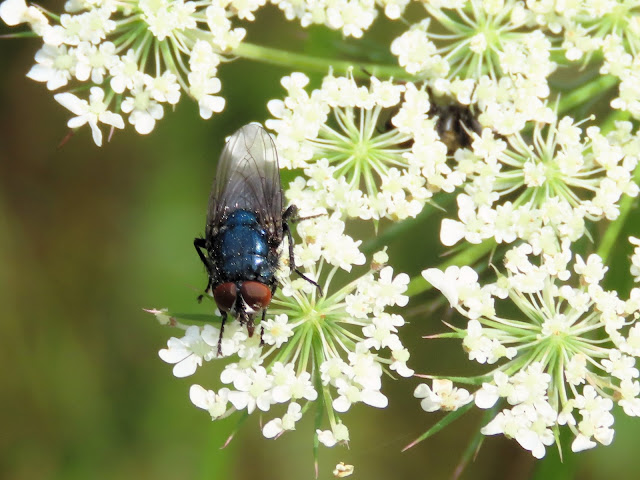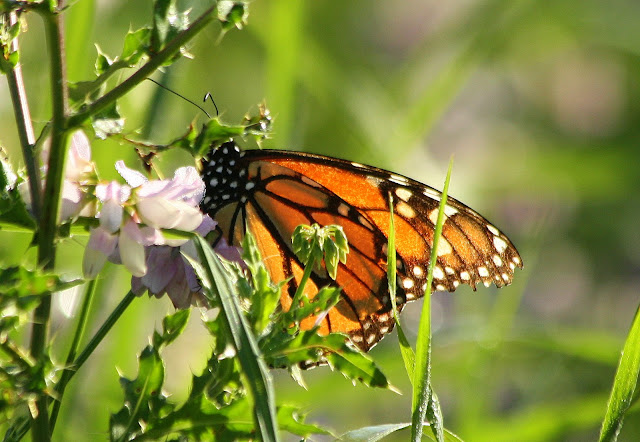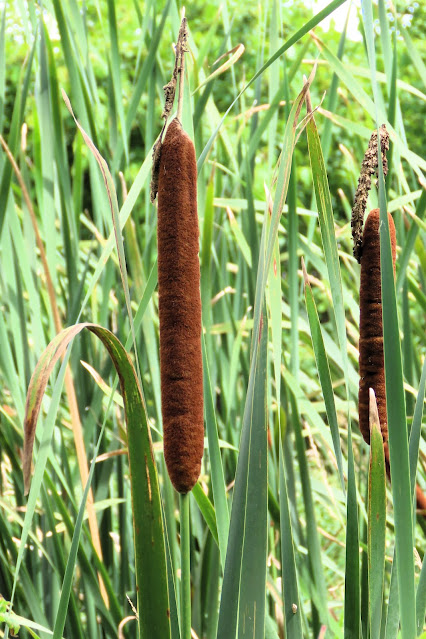14 August, 2023
We had lunch and I took a brief nap, so what better to do after that than to go for a walk along the Health Valley Trail?
No doubt the first Carolina Grasshopper we saw (Dissosteira carolina) agreed with me wholeheartedly.
Song Sparrows (Melospiza melodia) can always be counted on to enliven the landscape and entertain us with their cheery song.
Purslane is touted as a purgative, cardiac tonic, emollient, muscle relaxant and anti-inflammatory and diuretic treatment. It is alleged to benefit those suffering from osteoporosis and psoriasis.
I do not recommend its use in any way, I might add, and as is true for all medicinal remedies, it should not be taken unless on the advice of your physician.
Japanese Beetle (Popillia japonica) is beautiful, yet highly destructive.
The larvae chew on the roots of turfgrass and the adults damage the flowers and foliage of a wide variety of plants.
Regular readers of my blog will by now be familiar with Margined Calligrapher (Toxomerus marginatus), a delightful little hover fly.
The first part of the trail courses alongside fields of corn, and this tassel (known as silk) resembled a contemporary hair stylist's creation, where garish seems to be the order of the day.
A Chickweed Geometer Moth (Haematopis grateria) by comparison is a tasteful blend of colours; extremely pleasing to the eye.
A Jagged Ambush Bug (Phymata americana), as the name implies, hunts by ambushing its prey, leaping on them and injecting saliva through its short beak.
Often they are found on Goldenrod (genus Solidago) where they are cryptically camouflaged, but on this Wild Carrot (Daucus carota) they are quite conspicuous.
Generally regarded as beneficial insects, ambush bugs are not, however, highly esteemed by beekeepers due to their fondness for honeybees.
For the past half hour I have researched this grasshopper, but I am still not a hundred percent certain as to its identity. I have concluded that it is a Keeler's Spur-throat Grasshopper (Melanoplus keeleri), but if any melanophile out there would care to confirm or refute my assessment that would be great.
What a handsome fellow is a Band-winged Meadowhawk (Sympetrum semicinctum) on a bright summer's day.
A field filled with Perennial Sow Thistle (Sonchus arvensis) makes for a lovely sight, and the seeds are welcomed by American Goldfinches (Spinus tristis) many of whom are feeding young at this time of the year.
Viceroy (Limentis archippus), that master practitioner of Batesian mimicry, perched before us in a rare display of cooperation.
If I were into keeping beetles as pets a Red Milkweed Beetle (Tetraopes tetrophthalmus) would be high on my list of acquisitions.
I have wondered whether this phenomenon had anything to do with the composition of the soil, although that seemed unlikely, since one does not encounter entire stands of pinkish blooms. I have been unable to find anything in the literature to furnish an explanation for this variation, save a brief comment in Gray's Manual of Botany Eighth Edition (1950) - "flowers white or whitish, or all roseate to purplish..."
Plume Thistles (genus Cirsium) although unloved by many are transcendently beautiful to my eye.
The Blow Fly seen below is found in the genus Protocalliphora, a genus containing many species that are obligate parasites of birds, laying their eggs in bird nests. As long as maggot numbers are not high, they appear to have little effect on the nestlings, although fledging time may be delayed.
It's always encouraging to see Broadleaf Cattail (Typha latifolia), a buttress against the relentless advance of Common Reed (Phragmites australis).
It looks distinctive enough, but that hasn't helped me a great deal. I take comfort in the knowledge that spiders are often hard to identify beyond the genus (but I haven't even got that far with this one!) The best I can say is that is a member of the subfamily Theridiinae. Of that much I am fairly confident.
The caterpillar of a Milkweed Tussock Moth (Euchaetes egle) is by comparison easy-peasy.
As I do with all my posts I follow the sequence exactly as we encounter it; that way you can tag along with us. I hope you enjoyed this walk and are anxiously awaiting the next one.
I know I am.















































I delight in your/our walks and am definitely looking forward to the next. Thank you both.
ReplyDeleteMaravilloso tu reportaje, amigo David, nos has adentrado en el increíble mundo de los insectos y mariposas y una bonita fama de flores silvestres que adornan los campos.
ReplyDeleteMuchos besos y abrazos.
There is no doubt that you have a lot of knowledge about insects, David. I think the Viceroy and Monarch butterflies look similar. Are they related? Anyway, they are very beautiful.
ReplyDeleteHugs and kisses, Marit
Wonderful collection of insects and pretty flowers. Another nice walk and report. Take care, have a great day!
ReplyDeleteYou had another wonderful walk. I am always astonished at how much you see. Yesterday on my way to visit Heike I saw a wasp. But only after it had stung me, ouch! We have a lot of the same - or very similar plants and flowers here, but I can't tell you much about insects and spiders as I am not a fan! Have a great day, hugs, Valerie xxxxx
ReplyDelete...Davud, once again feww things miss your eye. Thanks for taking my along, I feel healthier now.
ReplyDeleteA nice adventure. All familiar critters here! I think the 2nd butterfly is also a Viceroy. I haven't seen any monarchs this year.
ReplyDeleteYou were right. Good eyes. I inadvertently used the wrong picture. I have now changed it.
DeleteHari Om
ReplyDeleteGorgeous... ta for the take along... and try Theridion Frondeum for your spider ID. YAM xx
As far as I can determine there are no records on Theridion frondeum in Canada. It is found in the southeastern United States and The Bahamas.
DeleteGreat report of such beautiful place!
ReplyDeleteInteresting picture of the flowers of Wild Carrot. Love those black and orange butterflies
What a great series of photos of your walks David.
ReplyDeleteI really love the monarch butterfly, we don't see this species in the wild here, but we do see it in the zoo.
The other species of butterflies and insects are also beautiful.
I enjoyed it.
Greetings Irma
Great walk through the health trap, David. I love ladybug, butterflies and bumblebees. They are such hard workers. They collect nectar for the winter. Great photos. Hugs.
ReplyDeletethat red meadowhawk is gorgeous, red being my favorite color. the grasshopper reminds me a lot of the dreaded crickets of my youth in Savannah GA... not exactly but close and the dreaded part was one of the loud mouth bugs getting in the house and keeping me awake at night. About that tassel, how big is it? you might could send it to me to use as a wig until my hair grows back 😁
ReplyDeleteI think it might fit!
DeleteThe wild carrot flower is very pretty! I had to go back and forth between the monarch and the viceroy to consider the differences. I'll admit that I assumed that all orange butterflies were monarchs. I haven't seen any here this year, just a few white moths (I presume) and a couple of yellow ones.
ReplyDeleteThanks for taking us along.
Thanks for the walk and for the wonderful pictures. A great way to start my day!
ReplyDeleteBuen paseo, con paradas obligatoria, para captar estas imágenes que con tanta generosidad nos ofreces.
ReplyDeleteUn abrazo
Thanks for the wonderful hike, beautiful photos and an informative narrative.
ReplyDeletePurslane is for sure edible! I bought them from Turkish stores here. Perennial Sow Thistles are beautiful.
ReplyDeleteThe grasshopper you couldn't name looks similar to the ones I grew up with in Minnesota prairie. The only name I knew was "grasshopper"--and knew it squirted yucky juice on you if you tried to pick it up--lol! I do so admire your knowledge of all the critters and the plants, too. :)
ReplyDeleteThe silk tassel and White Carrot are especially beautiful. I don't see them in Hawaii.
ReplyDeleteAs always, David (and Miriam), a wonderful post full of variety. It does, however, have some absolutely stand-out items which, for me, were the Monarch and Viceroy butterflies, the Japanese Beetles, the corn tassel, the Common Whitetail, and the Turkey Tail.
ReplyDeleteI see that you are working on contributions to the forthcoming 'Insex' title. How about that for a catchy name?
Best wishes to you and Miriam from UK where, after a cold wet summer, we are experiencing the hottest weather of the year. Take good care - - - Richard
Index sounds great!
DeleteInsex.
DeleteTravel with you and nature is always glorious. Thank you for allowing me to join you on the ventures :)
ReplyDeletePlenty of bugs and things today. Lovely sparrow.
ReplyDeleteI've never seen a yellow thistle before. It's quite pretty, as pretty as the purple flowers. You always find so many interesting species on your walk, and get some super photos too. I like all the insects you find. The variety is always staggering. I hope your week is going well. hugs-Erika
ReplyDeleteI think you could find it in New Hampshire, Erika.
DeleteWhat's up, dear friend! love accompanying you on their idyllic walks and one of the most beautiful things i have seen is the pink plant, i absolutely fall in love with it; plus the ladybugs and butterflies made my day better!
ReplyDeleteGreetings and have a nice nite! 💐༶⋆⋆🌷˙⊹☀️🌿🦋🌷
Love the nap bit :) Never seen wild carrot flower, it looks very nice.
ReplyDeleteThe photos are lovely as always.
Il y'a tellement à voir!
ReplyDeleteLa chenille est jolie, elle me fait penser à un cochon d'Inde :D
Bonne journée
Cudowny spacer! Ja uwielbiam chodzić po dzikim terenie i nie nastawiać się na żadne przygody, ale czerpać z tego, co daje natura. Piękne owady, kwiaty, ptaki, aż tu czuję ten zapach i szum łąki.
ReplyDeleteThere seems to be a time lag between the date of your posts and the dates of the related comments, the former being about three weeks behind the latter. Not that I'm complaining, y'unnerstand; unless you traded in your brain for a German taxonomy of natural Canada, I would imagine a good deal of research time goes into augmenting the information gathered on even the shortest of walks. I was astonished to find the previous walk to this was a mere 4 km long; you gave the impression you'd hopped on to a modern-day equivalent of The Beagle and cruised for a couple of months.
ReplyDeleteGiven your revelation on my blog, Tone deaf, about your age (it being closer to mine than I'd expected) I scrutinised the photo of the pair of you more closely. It wasn't that you might be asked your age if you ordered a beer in a pub, rather that you seemed to bursting with such good health that you could have passed for any age you liked; grandfather and grandson combined.
However there was a clue that you might be just a bit older than I'd thought. Those are expensive binocs and youth doesn't always have the cash for such things. During my aforementioned brief membership of RSPB I made do initially with a cheap pair but was quickly disabused of this foolish decision. In bird watching you need all the power, clarity and depth of field you can get. I suspect my subsequent purchase (poignantly stamped with the RSPB logo) isn't in your bracket but they'll do for me. They hang, ready for use, in my study and I bless the money I spent on them.
I see your posts seem to be broadly broken down into categories; this time insects seem to predominate. I do have have a burning subject to discuss but it has to do with bird watching. Hence I'm postponing it. In any case I have gone on far too long here and I must husband my resources of bird knowledge to avoid running out of conversation before the winter solstice. Always assuming there is a winter solstice.
I have to say that I am mightily pleased with your comments, and very happy that our paths have crossed. Though I might be tempted to reply at length, I must restrain myself since we will be leaving for the airport soon for a brief vacation on Vancouver Island, and a visit to one of Miriam’s sisters who lives in Victoria. My preoccupation right now is responding to Miriam’s calls of, “Did you remember to pack…….?” A couple of friends are going with us, to enjoy some birding before going to a wedding in Vancouver, and we have to swing by to pick them up. À bientôt, mon ami.
DeleteThanks for sharing the photos of a wonderful natural world.
ReplyDeleteI am not sure but I think I have the common purslane in my garden and, at the moment, it is not invasive.
David!
ReplyDeleteThank you very much for a beautiful walk in nature. Once again you present a great collection of insects and other creatures. I was delighted with the wild carrot flower. I've never seen a shade of pink.
Hugs and greetings.
Aplaudo o seu blog e a publicação que acabei de ler.
ReplyDeleteSou apaixonado por tudo quanto diz respeito à natureza e também procuro identificar os animais e plantas com que me vou deparando.
Obrigado pela partilha.
Abraço amigo.
Juvenal Nunes
Another interesting walk..I always enjoy them and learn so much..Nice to see these things through your eyes..(and Miriams camera)..Purslane is a very common weed here..easily pulled..You just made me think...I have not seen a Japanese Beetle this year..Very unusual..yes, indeed..Who doesn't love a Monarch?? Hard to photograph..they don't stay still very long..Enjoy the rest of your week..I think this may be the beginning of the end of our heat wave..
ReplyDeleteI certainly enjoy my walks with you.
ReplyDeleteUntil next time ... take care.
All the best Jan
A wonderful walk along with you David, as always. Loved the preponderence of pink in your post, my favourite being that wild corn silk. But so much else to enjoy too! Thank you.
ReplyDeleteXO
WWW
Hi David.
ReplyDeleteIt's wonderful to be able to enjoy your walk in nature online.
I think that Japsne beetle is super beautiful.
Also beautiful are the Grasshopper, Dragonfly and Butterflies.
Greetings from Patricia.
Hi David,
ReplyDeleteGreat walk and so much to see along the way. Beautiful, especially the beetles and the stunning butterflies.
Big Hug,
Maria
Hi David - excellent walk ... I note the next one will likely be on the VI island - and hope Miriam enjoys seeing her sister and you both enjoy the slightly different species across the great continent. Happy brief vacation ... cheers Hilary
ReplyDeleteI couldn’t think of the name of the sow thistle recently. Thank you for the reminder.
ReplyDeleteWe have been photographing caterpillars the last few weeks. Rick always spots them before I do. We are impressed with how quickly they move.
There is never a shortage of insects and blooms to attract one’s interest and of course, the birds…
Great post.
The wild carrot is gorgeous! And I love your close ups of all the bugs and insects. It's a wild world among the miniatures of the forest! Enjoy your Sunday!
ReplyDeleteGracias querido amigo por tan precioso reportaje, me encanta. Abrazos.
ReplyDeleteQuite a variety of little insects.
ReplyDeleteand I do enjoy your walks. y'all must be very sharp eyed. the field of sow thistle just sort of blew me away. I'm constantly pulling and digging the stuff out of my yard.
ReplyDeletePurslane is a huge problem here and it drives me crackers in the vegetable garden.
ReplyDeleteThe Japanese beetles are very pretty but…..
I tried growing corn, the first year they did well, the next two years they got (Carpophilus dimidiatus) and we did not get to eat any. I have not tried since.
That Red Milkweed beetle is very pretty, a new one on me, think they must be missing from Europe!
Sorry that I am not keeping up but life is just too busy!! Keep well, bisous mon ami, Diane
I did enjoy this walk. : )
ReplyDeleteHave an excellent holiday.
Of course this sequence of photos is very pleasant, thank you for this stroll David.
ReplyDeleteKisses and good day
ReplyDeleteAt the end of summer and beginning of autumn there is a good diversity of flowers and insects, at least where I live that happens. Great photos and species identification.